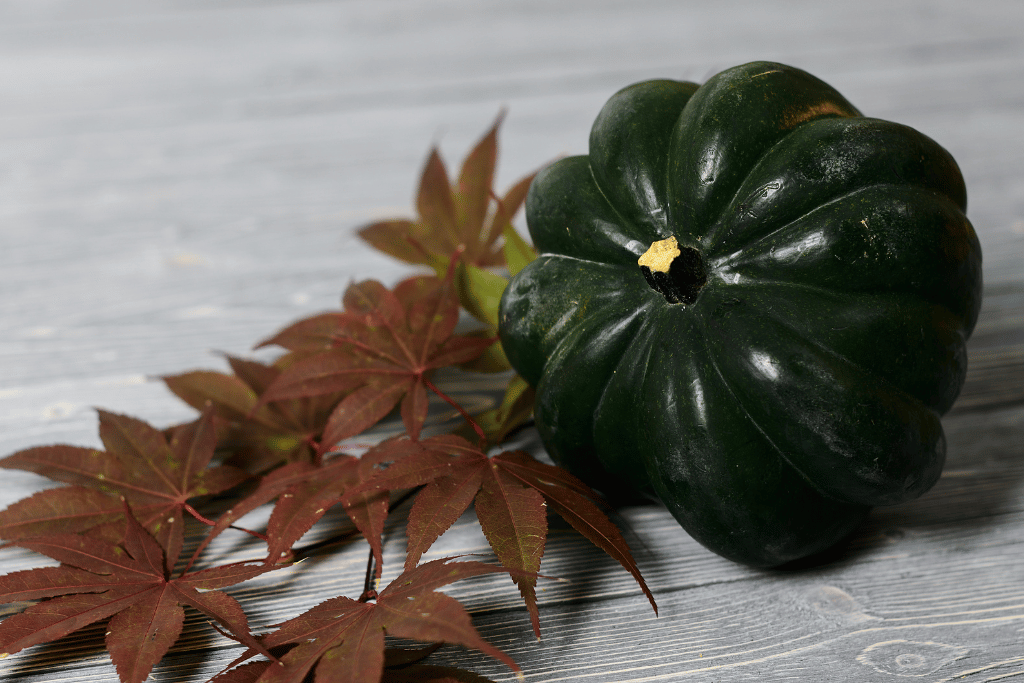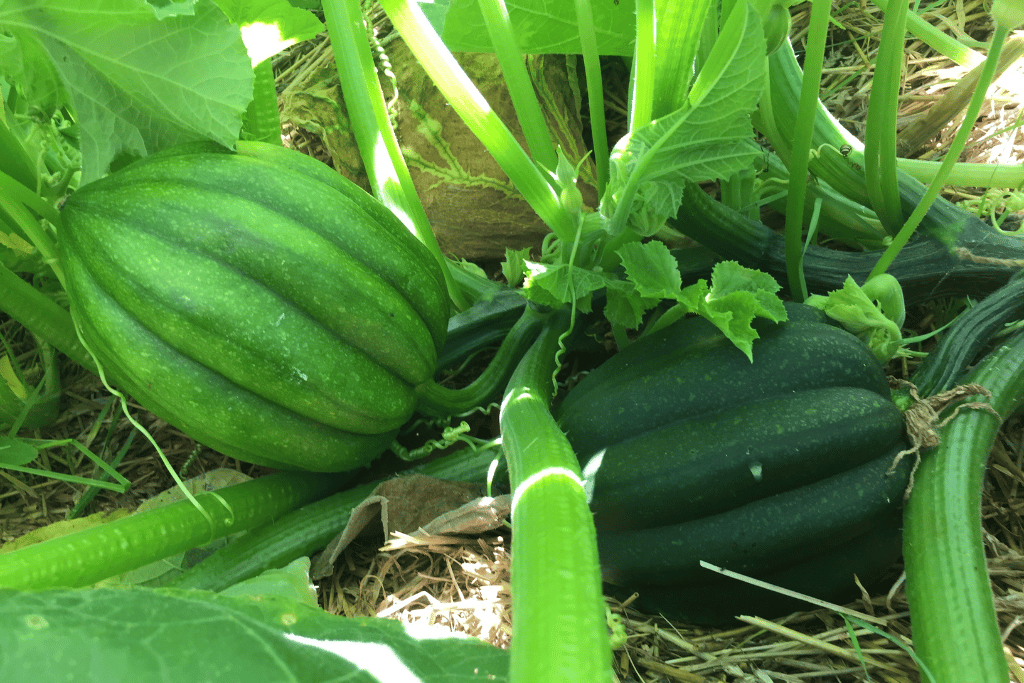
As the days get shorter and the air turns crisp, there’s nothing quite like the warm and comforting flavors of fall. One ingredient that perfectly captures the essence of the season is the humble acorn squash. With its vibrant color and unique flavor, this versatile gourd is a must-have for any autumnal feast. But how do you know when to pick acorn squash? Fear not, for I have all the tips and tricks you need to harvest your yield successfully. So put on your gardening gloves and let’s get picking!
Acorn Squash Basics

Acorn squash, also known as Des Moines squash, belongs to the Cucurbitaceae family, which includes pumpkins and zucchinis among others. This brilliant winter squash has a distinctive shape, resembling an acorn with its ribbed green exterior. When cut open, it boasts a vivid orange flesh that yields a slightly sweet and nutty flavor once cooked, making it a beloved ingredient in various fall dishes.
Just like the spaghetti squash, which is another beloved component of numerous meals, this emerald treasure is popular in the kitchen too. Roasted, mashed, or baked, this gourd is the highlight element of creamy soups and hearty stews. Its natural sweetness also makes it a perfect addition to pies and desserts, adding an autumnal touch to any dish. Besides being a kitchen staple, the unique shape and color of the acorn squash are fit for cozy and aesthetic homescapes.
When To Pick Acorn Squash: Indicative Signs

If you’re new to growing this special greenery in your garden, you might not be sure how to tell when the acorn squash is ready to be picked. Well, keep on reading, as there are a number of clear suggestive signs to look out for!
Color
One of the most obvious clues that an acorn squash is ready to be harvested is its color. A mature specimen has a deep green shade that is uniform and consistent across its entire surface. As the gourd ripens, it may also develop some yellow or orange spots, but these should not be dominant. In case you find that the produce is mainly yellow or orange rather than a rich dark green, chances are it’s overripe or started to decay.
Hardness of the Rind
Another key indicator of mature acorn squash is the solidity of its skin. Ideally, the rind is tough and hard to the touch, and it should not give when pressed with your finger. However, if the exterior feels soft or pliable, it may still be growing and developing, and it’s best to wait a few more days before harvest.
Size and Shape
Both factors are always excellent hints that help to determine whether a fruit or vegetable is to be collected. In the case of a Des Moines gourd, the length should be around 6 to 8 inches (15-20 cm) with a 4 to 6 inches (10-15 cm) diameter. Also, the overall shape is ideally symmetrical and uniform. When the fruit appears to be too small with an irregular shape, it’s recommended to leave it on the stem a bit longer.
Ripeness Test
One of the best ways to find out when to pick an acorn squash is to perform a pressure test on its skin. This is just as simple as it sounds. Gently press your thumbnail into the skin of the produce. If the rind is hard and does not give, the squash is likely matured and it’s time to harvest it. In case the skin is soft and gives when pressed, the fruit might still be growing.
Dry Vines
In addition to these main factors, there are a few other signs to keep an eye out for to know when an acorn squash is ready to be picked. For example, once the stem turns woody, dry, and brown, it’s your signal to detach the gourd from the vine. In contrast, a green and moist stem says that the produce still needs some time to ripen. Additionally, the leaves on the vine may start to turn brown and dry out as the fruit reaches maturity.
How To Pick Acorn Squash Like a Pro

If you’re looking to harvest acorn squash, there are a few things you need to keep in mind. For starters, you’ll want to make sure you have a sharp knife or clippers on hand. While you might be tempted to pull the gourd off the vine, cutting it off is the safest way to ensure you don’t damage the stem or other unripe specimens still on the vine.
It’s important to be gentle with your acorn squash during the harvesting process. You don’t want to yank it from the vine, as this could harm the unripe produce that you plan to harvest later on. Instead, you should carefully cut the ripe one free while leaving a small section of stem attached. This will help your squash to continue producing and ensure that it stays fresh for longer.
When it comes to making your cut, you should aim to leave at least an inch of stem on the mature fruit. If you want, you can leave up to 5 inches (about 12 cm) but somewhere in the range of 1 to 5 inches should be just right. This way the squash is able to retain moisture and escape early decay.
How To Cure Acorn Squash

Curing acorn squash is a process that helps to extend the shelf life of the gourd by hardening the skin and allowing it to store longer. To begin, make sure you choose a mature specimen that has a tough exterior without any soft spots or damage. Once you have selected the most suitable one, cut it from the vine leaving at least one inch of stem attached to it since it will act as a handle and help prevent any damage to the produce.
Next, wipe it clean with a damp cloth, being careful not to scrub too hard and scratch the exterior. During curing, the acorn squash will develop a protective layer of skin and the stem will dry and shrivel. This is a natural part of the procedure, which helps to avoid decomposition. It’s best to leave the gourd in a cool and dry place, such as a pantry or cellar for a couple of weeks or until the rind is hard and the stem is completely dried.
One of my most useful tips is to not put squashes on top of each other to prevent rotting and the emergence of soft spots. Instead, sort them out in rows. In addition, make sure not to leave them near fruits and vegetables that release ethylene gas, such as apples and bananas, as this potentially leads to spoiling more quickly.
With proper care and storage, acorn squash lasts up to 3-4 months. This way you can have access to fresh and flavorful fruits throughout the fall and winter months.
How To Store Acorn Squash
Freezing is the most effective method of preserving acorn squash for more than a few months. To ensure that the frozen fruit lasts for up to a year, it should be cooked before freezing. Begin by cutting off both ends of the gourd, removing the seeds and soft, stingy flesh from the center, and cutting the inside into cubes after peeling off its rind. And there you have it, ready to be used in a pressure cooker or directly added to other ingredients.
Closing Thoughts
Knowing when to pick acorn squash is key to enjoying its delicious taste. By following the recommendations outlined above, you can rest assured that your gourd is picked at the perfect time for peak flavor or pretty décor. Wishing you a fruitful and satisfying harvest!
Frequently Asked Questions (FAQ)
How many acorn squashes can one plant produce?
The number of acorn squash that a single plant produces depends on various factors such as growing conditions, plant size, and pollination. On average, a healthy plant can yield anywhere from 4 to 8 fruits, with some exceptional cases producing up to 10 or 12.
How do you know when to pick acorn squash?
To determine when to pick acorn squash, look for deep green, uniform color, solid rind, and a length of 6 to 8 inches with a 4 to 6 inches diameter. Pressing the skin should not leave an impression, and the stem should be dry and woody.
How long does it take to grow an acorn squash?
The time it takes to grow an acorn squash varies based on growing conditions and other circumstances. Generally, it takes around 80 to 100 days from planting to harvest time. The greenery requires warm temperatures, quality soil, and ample water for healthy growth and fruit production.



